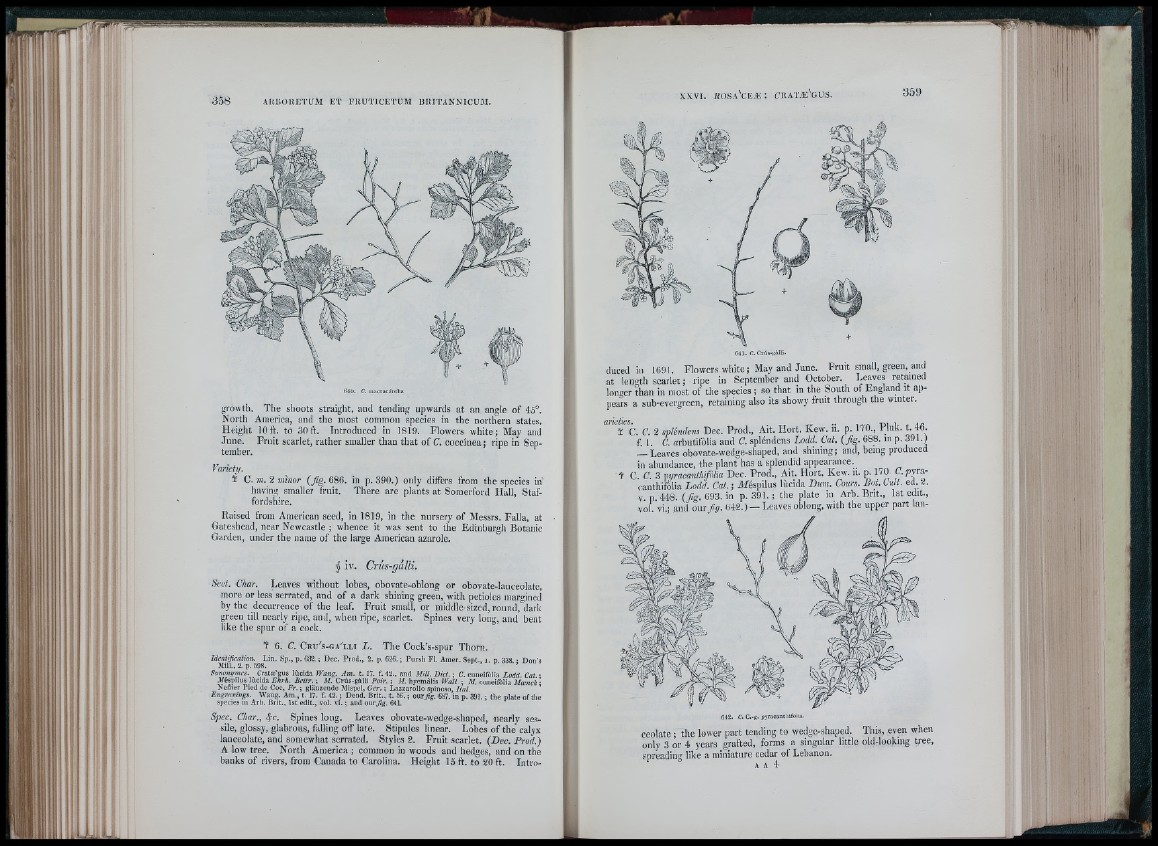
Ili
'i
l i f
ä h
i
6 10. C. m a crac àn th a
growth. The shoots straight, and tending upwEirds a t an angle o f 45°.
North America, and the most common species in the northern states.
Height 10ft. to 3 0 ft. Introduced in 1819. Flowers w h ite ; May and
June. F ru it scarlet, rather smaller than tliat o f C. coccínea; ripe in September.
Variety.
S C. m. 2 mtnor (fig . 686. in p. 390.) only differs from the species in
having smaller fruit. There are plants at Somerford Hall, Staffordshire.
Raised from American seed, in 1819, in the nursery of Messrs. Falla, at
Gateshead, near Newcastle ; whence it was sent to the Edinburgh Botanic
Garden, under the name of the large American azarole.
5 iv, C rú s-g á lli.
Sect. Char. Leaves without lobes, obovate-oblong or obovate-lanceolate.
more or less serrated, and o f a dark shining green, with petioles margined
by the decurrence of the leaf. F ruit small, or middle-sized, round, dark
green till nearly ripe, and, when ripe, scarlet,
like the spur oF a cock.
Spines very long, and bent
6. C. C r u ' s - g a ' l l i If, The Cock’s-spur Thorn.
^.denlificniion. L in . Sp., p. 632.; Dec. P rod., 2. p. 626.; P ursh Fl. Amer. Sept., i. p. 338. j Don’s
Mill., 2. p. 598.
Synonymes. Cratoe'gus lùcida Wang. Am. t. 17. f. 42., and Mül. Dict. ; C, cuneifòlia L odd Caí ■
JV/éspilus lùcida Ehrh. Beitr. ; M. Crús-gálli Poir. ; M. hyemàlis Walt ; M. cuneifòlia Moench ■
Neflier Pied de Coc, Fr. ; glänzende Mispel, Ger. ; Lazzarollo spinoso, Ital. ’
Engravings. Wang. Am., t. 17. f. 42. ; Dend. Brit., t. 56. ; ourjfg-. 687. in p. 391. ; th e plate of tlie
species in Arb. Brit., Is t edit., vol. vi. ; and ourjf^. 641.
Spec. Char., 4c. Spines long. Leaves obovate-wedge-shaped, nearly sessile,
glossy, glabrous, falling off late. Stipules linear. Lobes of the calyx
lanceolate, and somewhat serrated. Styles 2. F ru it scarlet. (Dec. Prod.)
A low tree. North America ; common in woods and hedges, and on the
banks o f rivers, from Canada to Carolina. Height 15 ft. to 20 ft. Introd
u c ed in 1691. Flowers white; May and June. Fruit small, green, and
at length sc a rle t; ripe in September and October. Leaves retained
longer than in most of the species ; so th a t in the South ot England it appears
a sub-evergreen, retaining also its showy fruit through the winter.
“" Z ' c . C. 2 splémlens Dec. Prod., Ait. Hort. Kew. ii. p. 170., Pluk. L 46.
f. 1. C. arbutifolia and C. spléndens Lodd. Cat. (Jig. 688. in p. 391.)
— Leaves obovate-wedge-shaped, and shining; and, being produced
in abundance, the plant has a splendid appearance.
? C. C. 3 mjracanthfòlìa Dec. Prod., Ait. Hort. Kew. ii. p. 170
canthifòlia Lodd. Cat. ; ibféspilus lùcida Dum. Cours. Boi. Cidi. ed. 2.
v. p. 44-8. (Jig. 693. in p. 391. ; the plate in Arb. B n t., 1st edit.,
vol. vi.; and ouxjig. 642.) — Leaves oblong, with the upper part lan-
642. C. C.-B. p j r a c a n t’.iitolia.
ceolate ; the lower part tending to wedge-shaped. This, even when
only 3 or 4 years grafted, forms a singular little old-looking tree,
spreadin« like a miniature cedar of Lebanon.
A A 4